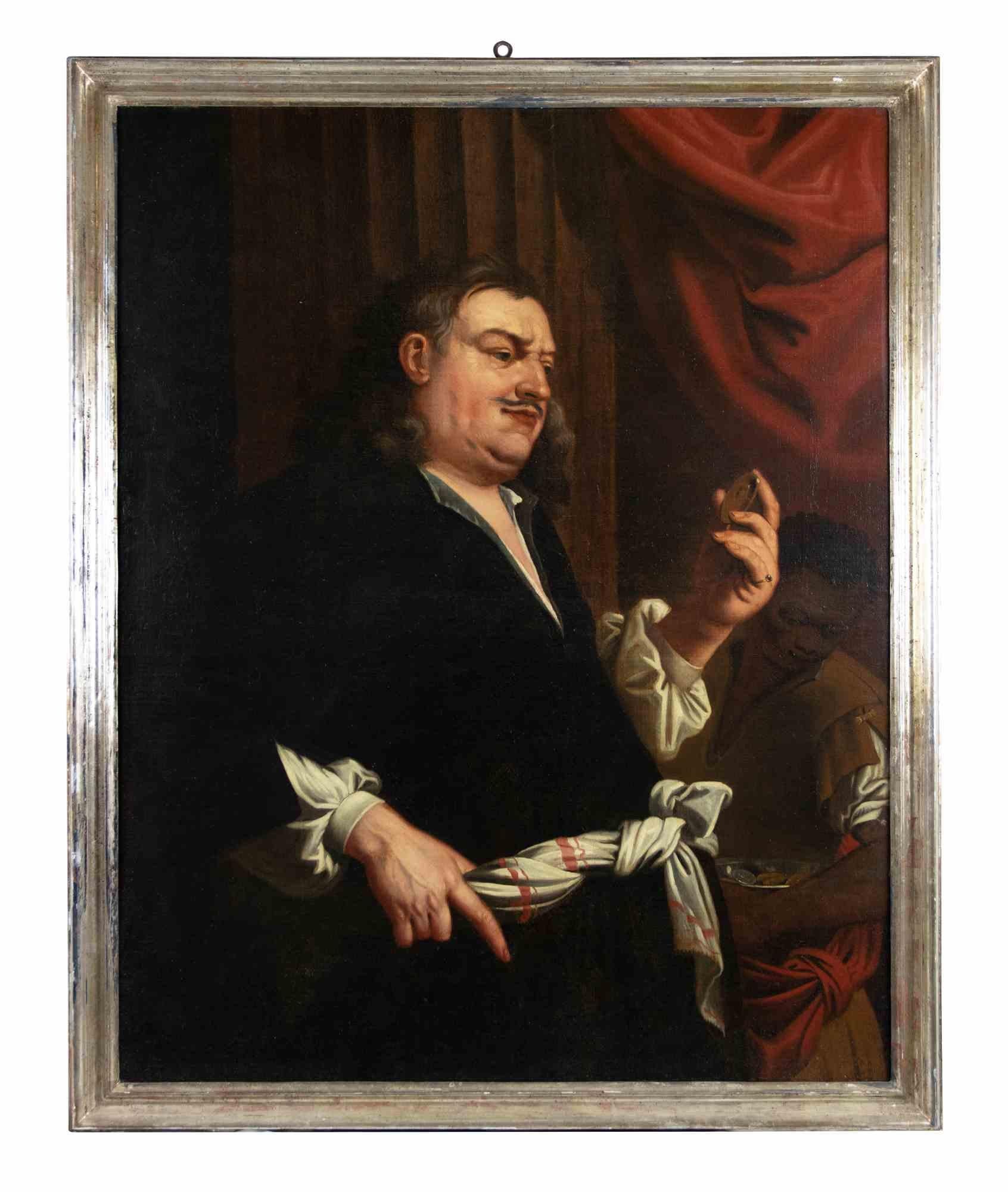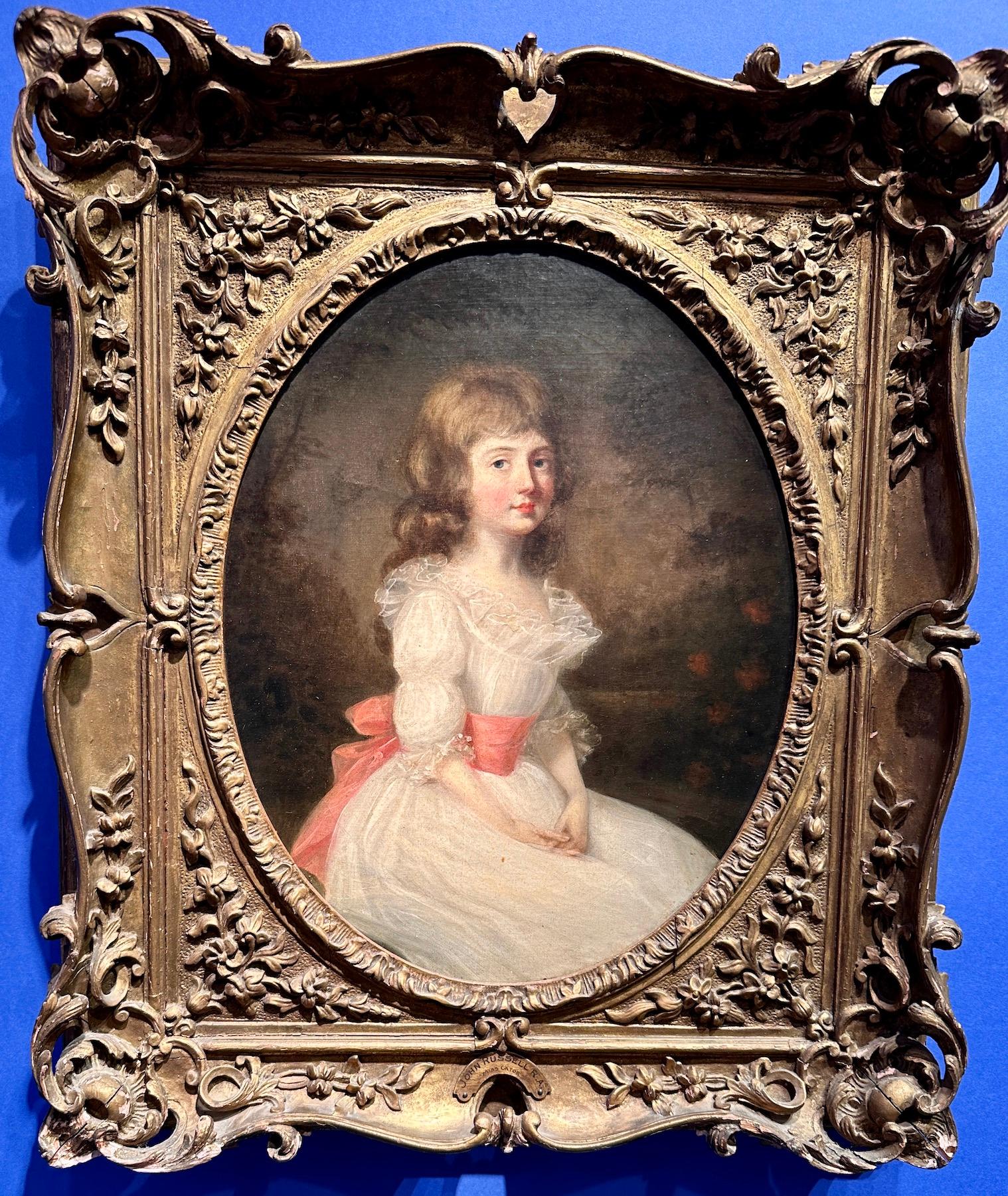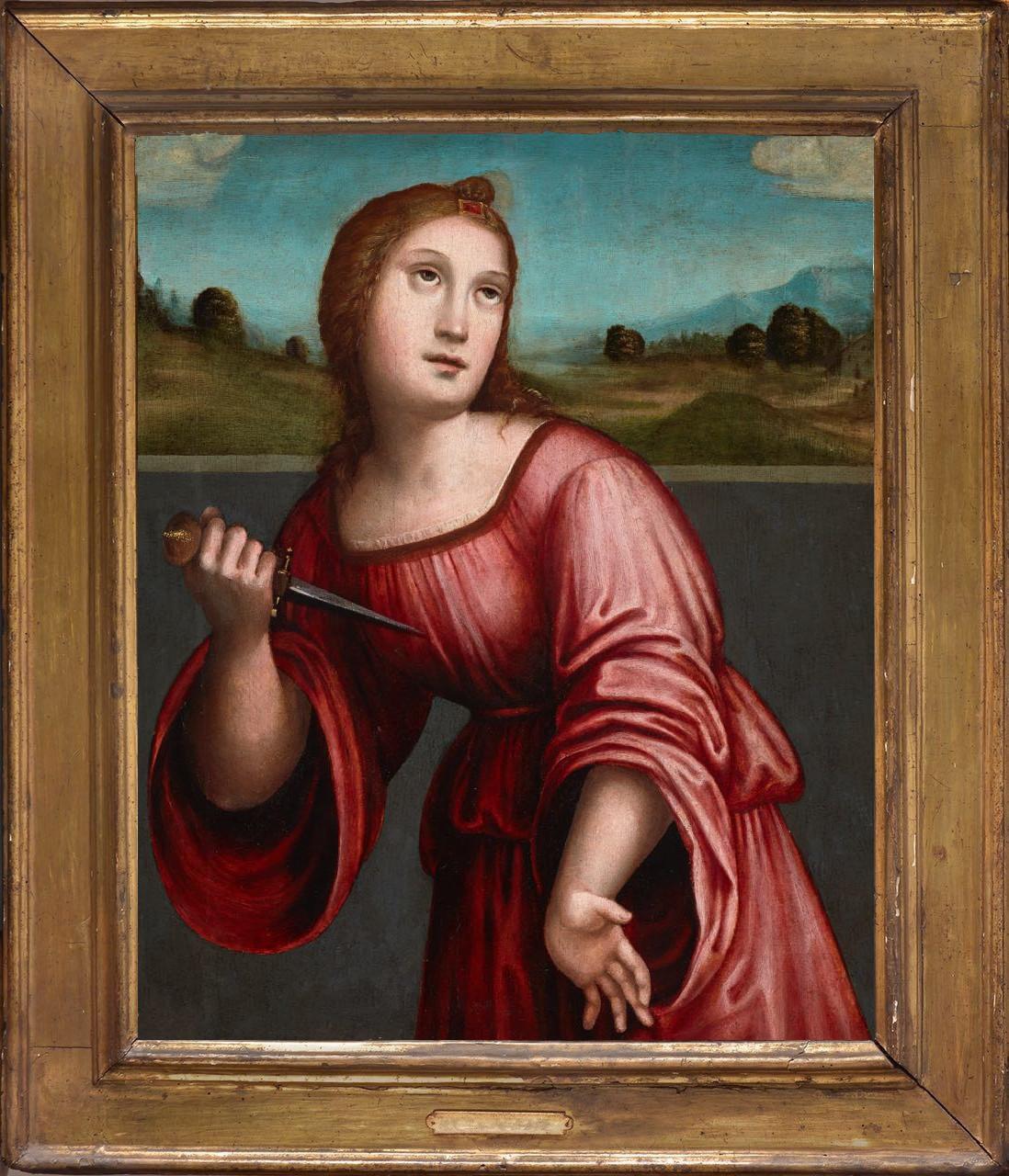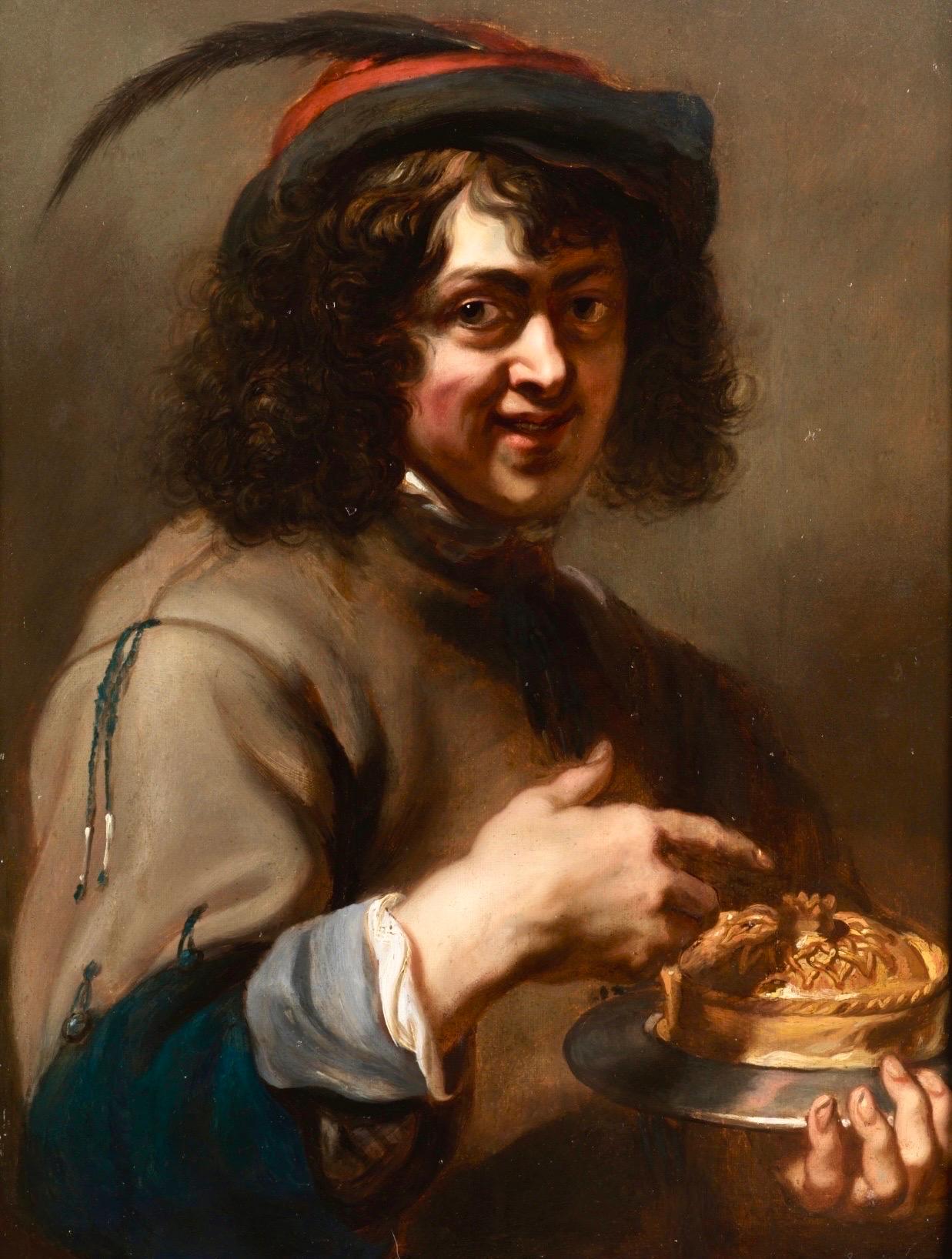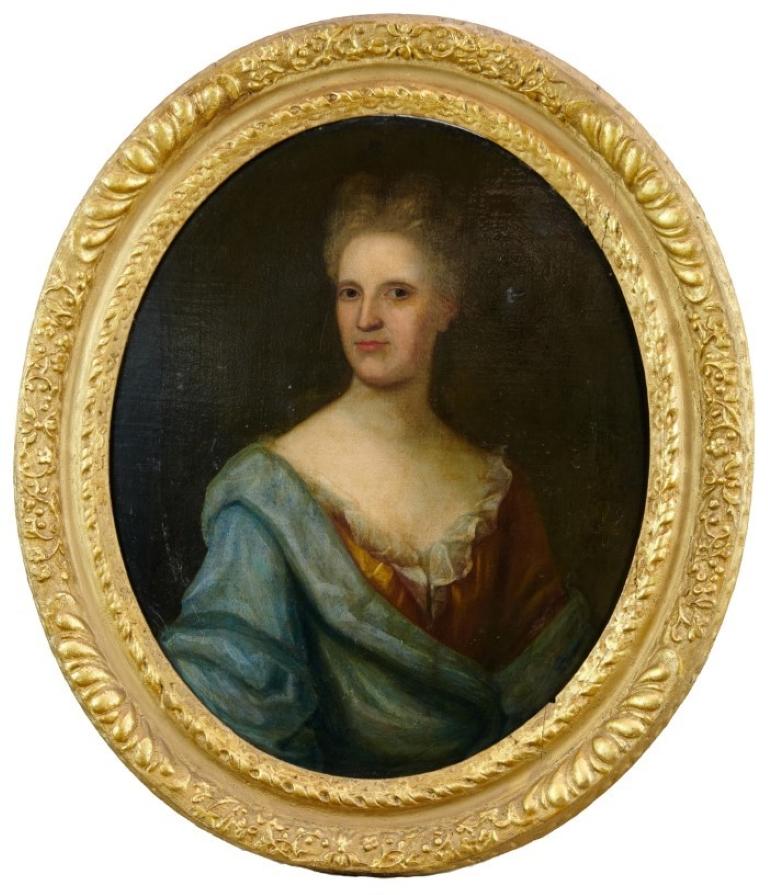Items Similar to Soldier in an Interior, Early 17th Century Dutch Oil
Want more images or videos?
Request additional images or videos from the seller
1 of 10
Pieter Symonsz PotterSoldier in an Interior, Early 17th Century Dutch Oil 1600-1650
1600-1650
About the Item
Pieter Symonsz Potter
Dutch 1600 - 1652
Soldier in an Interior
Oil on oak panel, red seal to reverse
Image size: 15 x 10 3/4 inches
Dutch Ebonised frame
Bathed in a well lit room, a man stands with his trusty dog in front of a map. His clothes – he is wearing boots with spurs, elegant outfit and a sword – suggest that he is a soldier. The map suggests he has travelled for his fighting and the spartan room.
The man holds a miniature portrait of a lady, so more than likely his wife who has passed away. Like most of Potter's soldier scenes this picture is most likely to be painted in Amsterdam in the 1630s.
Pieter Symonsz Potter
Pieter Symonsz Potter (1597, Enkhuizen – 1652, Amsterdam), was a Dutch Golden Age painter. According to Houbraken he was the city secretary of Enkhuizen, married to the daughter of Paulus Bertius and the father of the painter Pieter I Potter, making him the grandfather of Pieter II, Paulus, and Maria Potter. His wife was the sister of the painter Willem Bartsius, and he was the father, not the grandfather, of Pieter II, Paulus and Maria. He was first trained as a glass painter and in 1628 moved to Leiden to learn painting in oils. He is known mostly for genre pieces and farm landscapes, and he became a member of the Delft Guild of St. Luke in 1646, and a member of the Confrerie Pictura in 1647 (though this record in the The Hague guild archives may have been for drawing lessons for his oldest son Peter).
- Creator:Pieter Symonsz Potter (1600 - 1652, Dutch)
- Creation Year:1600-1650
- Dimensions:Height: 15 in (38.1 cm)Width: 10.75 in (27.31 cm)
- More Editions & Sizes:1 of 1Price: $9,791
- Medium:
- Movement & Style:
- Period:Early 17th Century
- Condition:Slight curve to panel.
- Gallery Location:London, GB
- Reference Number:1stDibs: LU52412883112
About the Seller
5.0
Gold Seller
These expertly vetted sellers are highly rated and consistently exceed customer expectations.
Established in 2007
1stDibs seller since 2014
66 sales on 1stDibs
Typical response time: 4 hours
- ShippingRetrieving quote...Ships From: London, United Kingdom
- Return PolicyA return for this item may be initiated within 3 days of delivery.
More From This SellerView All
- Reflections, American 20th Century Oil PaintingBy Philip Campbell CurtisLocated in London, GBPhilip Campbell Curtis American 1907 - 2000 Reflections Oil on board, signed and dated 1960 Image size: 12 ½ x 5 ½ inches Original frameCategory
1960s Surrealist Figurative Paintings
MaterialsOil
- Study of the Violinist for Holy Motherhood, pre-raphaelite, newlyn school, OilBy Thomas Cooper GotchLocated in London, GBThomas Cooper Gotch 1854 – 1931 Study of Violinist for Holy Motherhood Oil on canvas, on board Image size: 28 ¾ x 21 inches 18th century frame Illustrated in "The Golden Dream, A bi...Category
Early 1900s Aesthetic Movement Figurative Paintings
MaterialsOil
- Portrait of a Man, 17th Century Dutch Oil on Panel PortraitBy Cornelis DusartLocated in London, GBCircle of Cornelis Dusart Dutch 1660 - 1704 Portrait of a Man Oil on panel Image size: 7¾ x 5¼ inches Giltwood frame Cornelis Dusart Cornelis ...Category
17th Century Old Masters Portrait Paintings
MaterialsOil, Panel
- Portrait of a Young Man - 17th Century Portrait in OilBy Pieter Harmensz VerelstLocated in London, GBCircle of Pieter Harmensz Verelst 1618 - 1678 Portrait of a Young Man Oil on oak panel Image size: 7 ½ x 5 ¾ inches Dutch ripple frameCategory
18th Century and Earlier Old Masters Portrait Paintings
MaterialsPanel, Oil
- Portrait of an Officer, Cornelius Johnson, 17th Century Old MastersBy Cornelius JohnsonLocated in London, GBCircle of Cornelius Johnson Circa 1620’s Portrait of a Officer Oil on canvas Image size: 28 x 24 inches Period style hand made frame Provenance Private European Estate This striking portrait dates to around 1620, as you can see from the images of the sash the detail is very high. The sash is decorated with gold thread and would have cost a small fortune at the time. Sashes were originally developed for a military function (making officers more visible for their men during combat), but soon became a primarily male fashion...Category
Early 17th Century Old Masters Portrait Paintings
MaterialsOil
- Portrait of William Herbert, 3rd Earl of Pembroke, Early 17th Century PortraitLocated in London, GBEnglish School, (circa 1600) Portrait of William Herbert, 3rd Earl of Pembroke Oil on panel, oval Image size: 29¼ x 23⅞ inches Painted wooden frame Provenance: 176, Collection of Francis Greville, 1st Earl of Warwick. The Trustees of the Lord Brooks’ Settlement, (removed from Warwick Castle). Sotheby’s, London, 22nd March 1968, lot 81. Painted onto wooden panel, this portrait shows a dark haired gentleman in profile sporting an open white shirt. On top of this garments is a richly detailed black cloak, decorated with gold thread and lined with a sumptuous crimson lining. With the red silk inside it’s all very expensive and would fall under sumptuary laws – so this is a nobleman of high degree. It’s melancholic air conforms to the contemporary popularity of this very human condition, evident in fashionable poetry and music of the period. In comparison to our own modern prejudices, melancholy was associated with creativity in this period. This portrait appeared in the earliest described list of pictures of Warwick castle dating to 1762. Compiled by collector and antiquary Sir William Musgrave ‘taken from the information of Lord & Lady Warwick’ (Add. MSS, 5726 fol. 3) is described; ‘8. Earl of Essex – an original by Zuccharo – seen in profile with black hair. Holding a black robe across his breast with his right hand.’ As tempting as it is to imagine that this is a portrait of Robert Devereux, the 2nd Earl Essex, we might take this with a pinch of salt. Its identification with this romantic and fatal Elizabethan might well have been an attempt to add romance to Warwick Castle’s walls. It doesn’t correspond all that well with Essex’s portraits around 1600 after his return from Cadiz. Notably, this picture was presumably hung not too far away from the castle’s two portraits of Queen Elizabeth I. The first, and undoubtedly the best, being the exquisite coronation portrait that was sold by Lord Brooke in the late 1970s and now hangs in the National Portrait Gallery. The second, described as being ‘a copy from the original at Ld Hydes’, has yet to resurface. The portrait eventually ended up being hung in the State Bedroom of Warwick Castle. Archival documents present one other interesting candidate. The Greville family’s earliest inventory of paintings, made in 1630 at their home Brooke House in Holborn, London, describes five portraits of identified figures. All five belonged to the courtier, politician and poet Sir Fulke Greville (1554-1628), 1st Baron Brooke, and were hung in the ‘Gallerie’ of Brooke House behind yellow curtains. One of them was described as being of ‘Lord of Pembrooke’, which is likely to have been William Herbert (1580-1630), 3rd Earl of Pembroke. William was the eldest son of Greville’s best friend’s sister Mary Sidney, and was brought up in the particularly literary and poetically orientated household which his mother had supported. Notably, the 3rd Earl was one of the figures that Shakespeare’s first folio was dedicated to in 1623. The melancholic air to the portrait corresponds to William’s own pretensions as a learned and poetic figure. The richness of the robe in the painting, sporting golden thread and a spotted black fabric, is indicative of wealth beyond that of a simple poet or actor. The portrait’s dating to around the year 1600 might have coincided with William’s father death and his own rise to the Pembroke Earldom. This period of his life too was imbued with personal sadness, as an illicit affair with a Mary Fitton had resulted in a pregnancy and eventual banishment by Elizabeth I to Wilton after a short spell in Fleet Prison. His illegitimate son died shortly after being born. Despite being a close follower of the Earl of Essex, William had side-stepped supporting Devereux in the fatal uprising against the Queen and eventually regained favour at the court of the next monarch James I. His linen shirt is edged with a delicate border of lace and his black cloak is lined on the inside with sumptuous scarlet and richly decorated on the outside with gold braid and a pattern of embroidered black spots. Despite the richness of his clothes, William Herbert has been presented in a dishevelled state of semi-undress, his shirt unlaced far down his chest with the ties lying limply over his hand, indicating that he is in a state of distracted detachment. It has been suggested that the fashion for melancholy was rooted in an increase in self-consciousness and introspective reflection during the late 16th and early 17th centuries. In contemporary literature melancholy was said to be caused by a plenitude of the melancholy humor, one of the four vital humors, which were thought to regulate the functions of the body. An abundance of the melancholia humor was associated with a heightened creativity and intellectual ability and hence melancholy was linked to the notion of genius, as reflected in the work of the Oxford scholar Robert Burton, who in his work ‘The Anatomy of Melancholy’, described the Malcontent as ‘of all others [the]… most witty, [who] causeth many times divine ravishment, and a kind of enthusiamus… which stirreth them up to be excellent Philosophers, Poets and Prophets.’ (R. Burton, The Anatomy of Melancholy, London, 1621 in R. Strong, ‘Elizabethan Malady: Melancholy in Elizabethan and Jacobean Portraits’, Apollo, LXXIX, 1964). Melancholy was viewed as a highly fashionable affliction under Elizabeth I, and her successor James I, and a dejected demeanour was adopted by wealthy young men, often presenting themselves as scholars or despondent lovers, as reflected in the portraiture and literature from this period. Although the sitter in this portrait is, as yet, unidentified, it seems probable that he was a nobleman with literary or artistic ambitions, following in the same vain as such famous figures as the aristocratic poet and dramatist, Edward de Vere...Category
Early 17th Century Old Masters Portrait Paintings
MaterialsWood Panel, Oil
You May Also Like
- Fine 17th Century Italian Old Master Oval Portrait of Lady on Copper Wooden FrmLocated in Cirencester, GloucestershirePortrait of a Lady (female saint?) Italian School, 17th century oil on copper, framed frame: 9 x 8 inches board: 5 x 4 inches provenance: private collection condition: very good and ...Category
17th Century Old Masters Figurative Paintings
MaterialsOil
- A Rich Merchant - Painting by Unknown - 18th CenturyLocated in Roma, ITA rich merchant is an original old master artwork realized in the 18th Century. Mixed colored oil painting on canvas depicting a merchant looking at a coin in his left hand. Provena...Category
18th Century Old Masters Figurative Paintings
MaterialsOil
- 18th century Portrait of a young girl, Miss Cator in a landscape, white dressBy John RussellLocated in Woodbury, CTPortrait of a young British Girl, in her white dress with Pink Sash. Choosing to acquire an 18th-century portrait of a young girl by English artist John Russell is an opportunity to...Category
1780s Old Masters Portrait Paintings
MaterialsCanvas, Oil
- Lucretia, by Giacomo Raibolini Francia. Detto il Francia. Oil on panel, framedLocated in Brooklyn, NYGiacomo used to paint with his brother Giulio, identifying their works with the monogram «I I». The strong influence of his father, Francesco, is undeniable in all his works, althoug...Category
16th Century Old Masters Figurative Paintings
MaterialsOil, Wood Panel
- 17th century Flemish Old Master - A young boy enjoying a pie, allegory of tasteLocated in Antwerp, BE17th century Flemish old master painting, Allegory of taste The very fine painting depicts a young boy, cheekily tasting a delicious pie. He's looking at the viewer with eyes twinkl...Category
17th Century Old Masters Figurative Paintings
MaterialsCanvas, Oil
- Fine 18th Century English Aristocratic Portrait of a Lady Oval Canvas Gilt FrameLocated in Cirencester, GloucestershireArtist/ School: English School, circa 1740's Title: Portrait of a Lady, traditionally identified as 'Anne of Chesterfield'. Medium: oil painting on canvas, framed Size: painting: ...Category
Early 18th Century Old Masters Portrait Paintings
MaterialsCanvas, Oil
Recently Viewed
View AllMore Ways To Browse
17th Century Dutch
Antique 17th Century Dutch
Dutch Red
Portrait Of An Old Man
Antique Clothes Stand
Reverse Glass Portrait
Miniature Portrait Antique
Old Master Picture
Dutch Golden Age
Framed Miniature Portraits
Boots Painting
Antique Portrait Miniature Painting Paintings
Antique Portrait Miniature Paintings
Antique Miniature Portrait Painting
Old Swords
Antique Record Stand
Dutch 17th Century Portrait Painting
Potters Stand

